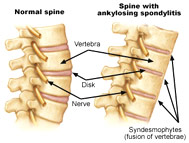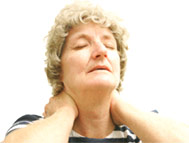


What is cervical spondylosis?
Spondylosis is a term referring to degenerative osteoarthritis of the joints of the spinal vertebrae. If severe, it may cause pressure on nerve roots with subsequent sensory and/or motor disturbances, such as pain, paresthesia, or muscle weakness in the limbs.
When the space between two adjacent vertebrae narrows, compression of a nerve root emerging from the spinal cord may result in radiculopathy (sensory and motor disturbances, such as severe pain in the neck, shoulder, arm, back, and/or leg, accompanied by muscle weakness). Less commonly, direct pressure on the spinal cord (typically in the cervical spine) may result in myelopathy, characterized by global weakness, gait dysfunction, loss of balance, and loss of bowel and/or bladder control. The patient may experience a phenomenon of shocks (paresthesia) in hands and legs because of nerve compression and lack of blood flow. If vertebrae of the neck are involved it is labelled cervical spondylosis.
Cervical spondylosis is a disorder caused by abnormal wear on the cartilage and bones of the neck with degeneration and mineral deposits in the cushions between the vertebrae. The bones of the neck are called cervical vertebrae. The cushions between the vertebrae are called cervical disks. The abnormal wear on the cartilage and bones of the neck can gradually compress one or more of the nerve roots. When nerve roots are compressed, pain in the neck and arm, weakness, and changes in sensation will occur. In advanced cases of cervical spondylosis, the spinal cord maybe become compressed. If the spinal cord becomes compressed, the pain, weakness and changes in sensation will also occur in the legs. Cervical spondylosis is also called cervical osteoarthritis.


Cervical spondylosis is a disorder caused by abnormal wear on the cartilage and bones of the neck with degeneration and mineral deposits in the cushions between the vertebrae. The bones of the neck are called cervical vertebrae. The cushions between the vertebrae are called cervical disks. The abnormal wear on the cartilage and bones of the neck can gradually compress one or more of the nerve roots. When nerve roots are compressed, pain in the neck and arm, weakness, and changes in sensation will occur. In advanced cases of cervical spondylosis, the spinal cord maybe become compressed. If the spinal cord becomes compressed, the pain, weakness and changes in sensation will also occur in the legs. Cervical spondylosis is also called cervical osteoarthritis.


What Causes Cervical Spondylosis?
Top
Cervical spondylosis is caused by chronic degeneration of the cervical spine, the cushions between the neck vertebrae, and joints between the bones of the cervical spine. A previous neck injury can predispose to a person to cervical spondylosis.
What are the Symptoms of Cervical Spondylosis?
Top
The most common symptoms of cervical spondylosis are:
- Neck pain (may radiate to the arms or shoulder)
- Loss of sensation or abnormal sensations of the shoulders, arms
- Weakness of the arms
- Neck stiffness that progressively worsens
- Loss of balance
- Headaches Loss of control of the bladder or bowels

Cervical Spondylitis




